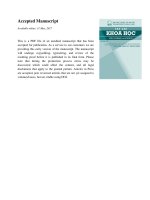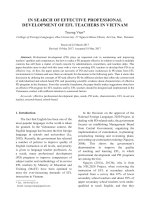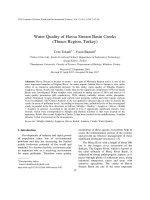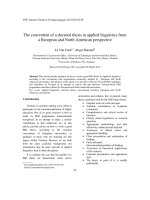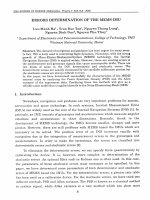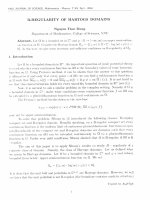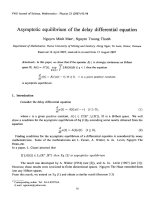DSpace at VNU: Extending froperty of infinite direct sums of uniform modules
Bạn đang xem bản rút gọn của tài liệu. Xem và tải ngay bản đầy đủ của tài liệu tại đây (2.56 MB, 8 trang )
VNU. JOURNAL OF SCIENCE. M athem atics - Physics. T .X V III. N q2 - 2002
E X T E N D IN G
PRO PERTY
O F IN F IN IT E
D IR E C T S U M S O F U N IF O R M
M ODULES
N go Si T u n g
D e p a rtm e n t o f M a th e m a tic s, V inh U n iversity
B u i N h u Lac
D e p a rtm e n t o f M a th e m a tic s, N am D inh C ollege o f P ed a g o g y
I n tr o d u c tio n
Let R be any ring and M = © ,e/A /i be a direct sum of uniform right R - submodules
M i ,i £ /. We are interested ill the question, when this module M is extendible. If the
index set / is finite, this question has been studied by Harmanci and Sm ith Ị6). In deed,
Harmanci and Sm ith have shown th at if M = 0™=1Aft, then M is extendible if and only
if every direct summand of A/ with uniform dimension 2 is an extending module, where
each M t is uniform, [(), Theorem 3].
In the first part of this paper we give some conditions for A/ to be extendible,
where the index set / is not necessarily finite. We show th a t a module over ail arbitrary
ring is extendible if it has (1 —C l) and every local direct sum m and is a direct summand.
Moreover, properties of extending modules have been obtained.
In the last part, of the paper the results have been applied to characterize quasiFrobeniüS rings and rings whose projective right modules are extendible.
2. P re lim in a rie s
Throughout this paper all rings R are associative rings with identity and all R modules are unitary right R- modules.
We consider the following conditions on a module A/:
(Cl) Every submodule of M is essential in a direct sum m and of M .
(C 2 ) Every submodule isomorphic to a direct sum m and of M is itself a direct
summand of M .
(1 - C l) Every uniform submodule of M is essential in a direct sum m and of A/..
A module M is called co n tin u o u s if it satisfies conditions (C l) and (O 2 ), V -co n tin u o u s
if it satisfies (C 2 ) and (1 —C l).
A module M is said to be an extending m odule if it satisfies condition (CY), and
M is said to have the exten d in g property o f u n ifo rm subm odule if it satisfies condition
(1 -Cx).
A submodule y\ of a module A Í is closed in M , it it has no proper essential extensions
in M . It is easy to check th a t ' M is an extending module if and only if every closed
submodule of M is a direct sum m and of M.
52
E x t e n d i n g p r o p e r ty o f in fin ite direct s u m s o f u n i f o r m m o d u le s
53
A moduli’ M is s.lid to have finite uniform dimension if M does not contain an
infinite direct Slim non-’/rrn sn!>niodul(\
A ring IỈ is
Qiiiisi - Frobc?nii.is (brioilv Q F ) if ÍỈ is right artinian and right
self - ilijfTtivn. It is knn\v that a ring IỈ is Q F if every projectiw /? - moduli' is injrct ivf*
if Í*very injcr.l ivr IỈ - m o d u lo is projectiVC? (See [4, T h e o r e m 24.20]).
A ring f i is
1) Evrry injrrlivc li modulo is n lifting module.
2 ) /? is I!j;ht at t i i i i au in w hich e v e ry no n - s m a ll IỈ- m o d u le c o n ta in s <\ non -zero
in je c tiv r siil>mo
3) /Í is rit»ht pel ltd ;md the family of all injective /?- module's is dosed undi'r taking
s m a ll ro v e rs , i.r loi ;>!IV I'Xiic! seq u ru n * p —> E —> 0 w h ere E is injcTt.ivr a n d korf is sm all
in Py p
is
ilijcH't iv<‘.
Ỉ) E very l\
module is
module*.
Dually a ring IÌ is Ciilled a r ig h t CO — H r in g |8. Theorem II] ii it satisfies one of
tin* f o l l o w i n g e q u i v n l r n t
c o n d it io n s :
1) E v r r v p ro je c t ÌV(' /ĩ-in o d u lí' is an e x t e n d in g m o d u le .
2) /? satisfices a<<* <»11 right annihilator ideals and every non-cosmall /^-moduli' con
tains i\ non-zero projcct iv<‘ (lin'd summand.
Thi' family of^ll projective ỈỈ’ modules is closed under taking essential extensions.
4) E v e ry I I
module is ('Xprossrtl as <) direct sum o f a p ro jective m odule and a
singular module.
For a subm odule X of M , x ç c M moans th at A ill an essential submodule of A/.
TU r injective hull of a moduli' A/ will bo denoted by E ( M ) .
Let M
(Ị)j, I M, !)<' a
3. D ire c t s u m s o f u n ifo rm m o d u le s
L e m m a 1. (Ị2y P ìoposititììi 2,2) or Ị6 ị L em m a 1). L e t M b e any m o d u le a n d K ç L be
su b m o d u les o f M such th a t K is closed ỈIÌ L find L is closed in M . T h o u K is a closed
su b m o d u le o f M .
T h e follow ing K'suh is obvious.
L e m m a 2. L e t M hỉivr (1 - ('}). T h en every d irect s u m m a n d o f M also h a s (1 —C l).
L em m a 3. Lei M
0 ,, IM , be a direct su m o f uniform m o d u le s M t , i 6 /. T Ik '11 a ny
non-y,cio suntĩKHÌìỉh' o f M contains cl uniform su b m o d u le.
Proof. Let A l><‘ a lion zero submodule of M . Then there exists a subset ./ of / which is
maximal with rrspc'ct to / I n A /(J) = 0.
Consider A- 6 I \ I and lot Ilfc be the projection
II, :
N g o S i T u n g , B u i N h u L ac
54
Let A k = A n ( M k ® M ( J )). By the choice of J,
is non- zero. Since j4fcHM(.7) — 0,
wo have
i4 f c * n fcC A k)c Af*.
Therefore A k is a uniform submodule of .4.
L e m m a 4. L e t M be a m o d u le w ith (1 —C l) a n d X © u b e a closed su b m o d u le o f M ,
w here X is a d irect s u m m a n d o f M a n d u is a u n ifo rm s u b m o d u le o f M . T hen X ® Ư is
a direct, su m m a n d o f M .
Proof. Let M = X © M 1 for some submodule Ml of M and II : M —> Ml be the projection.
Now let u be a uniform submodule of M with Ư n X = 0. Let V be a maximal essential
extension of n(ỉ7) in À /l. Since u = n ([/), V7 is uniform. By Lemma 2. M l has (1 —C l).
Consequently V is a direct sum m and of M l. Thus V is a direct sum m and of M . Moreover,
it is easy to check that
X ® u ç r r l (v ) ç X © V.
Since V is uniform, we obtain X ® u c e X ® v . It follows th at x ® v and s o X © ư
is a direct summand of M .
□
C o ro lla ry 5. L e t M b e a m o d u le w ith (1 —C l). I f M has fin ite u n ifo rm dim ension, th en
M is a fin ite direct sum o f uni form su b m o d u les.
P ro p o s itio n 6. L e t M b e a m o d u le w ith (1 - C l) a n d A b e a closed su b m o d u le o f M .
I f A has finite uni form d im en sio n th en A is a direct s u m m a n d o f M .
Proof. By Lemma 1, A has (1 —C l). Hence, by Corollary 5, A has a direct, sum decom
position
A = A I © • • • © i4n ,
where each A x is uniform. By induction on n and by using Lem ma 4, we can show that
A = {A \ © • • • © j4n_ i) © An is a direct sum m and of M .
4
C o ro lla ry 7. (see [7, P ro p o sitio n 3j). L e t M be a m o d u le w ith (1 - C l), then every
closed s u b m o d u le o f th e fo rm ©"=1-4, , w ith all A , unifo rm , is a d irec t su m m a n d o f M .
C o ro lla ry 8. ([7, P ro p o sitio n 6j). L e t M = ©ig/Af, w ith aìỉ M , uniform , u M has
(1 - C l), th en e v e ry non- zero closed s u b m o d u le o f M co n ta in s a u n ifo rm d irect su m m a n d
of M.
Proof. Let A be a closed submodule of M . By Lemma 3, there exists a uniform closed
submodule V of A . By Lemma 1, V is closed in M . Since M has (1 - C l), V is a direct
summand of M
□.
It is clear that the extending modules have (1 - C l), but the following example
shows that the converse is not true.
E x t e n d i n g p r o p e r ty o f i n fin ite direct s u m s o f u n i f o r m m o d u le s
E x a m p le 9. Tlicỉi'
a /
55
- m o d u lo w ith (1 —C l), such th a t it is n o t an e x te n d in g
m o d u li'.
f ’m of. L('t F !)(' ail infinirdy ffm vriitexi free abelian group. Then F — © ,€/(/,, where / is
an infinite set and r , -1 Zs for all i 6 L Since F has infinite rank, F is not an extending
module1 ([8, p. 19; or [(). p.3;).
Now le t /1 b e a u n ifo rm closed s u b m o d u le o f F. S in c e F is a h e r e d i t a r y Z - m o d u le
Mini A is uniform Wf c an show that .4 is a finitely generated z - module. Then there exists
a finite direct sum A' : t'ri © - • • ® ơn . where {1, • • ■,n } c / , such th a t A ç X. Since
,Y is Mil ('Xtondiĩig m o d u le by 8 , p. 19], A is a d ir e c t s u m m a n d o f X , a n d h en ce also o f F.
Thus F has ( i —Cl ).
A fam ily { M , : / 6 /} o f s u b m o d u le s o f a m o d u le M is called a local direct s u m m a n d
is d irect a n d V : p A/i is a d ir e c t s u m m a n d o f M for e v e ry finite s u b se t
F of I.
T h e following result gives a c o n d itio n w h en a d irec t s u m o f u n if o r m m o d u le s is
('Xtrndiblf*.
□
T h e o re m 10. Lot M hr ci/j R -m o d u ie such th a t M is a d irect s u m o f uniform m o d u les
A/,. / € I ỈIÌKÌ a ssu m e i licit every local d irect s u m m a n d o f M is a d irect su m m a n d . T h en
M is HU e x te n d in g m o d u le i f And o n ly i f M has (1 - C l).
Proof. Let M be an extending module. Obviously, M has (1 —C l).
Conversely, let M ■ y ]í(?J M ị. where each M l is uniform and assume th at any local
direct sum m and of M is a direct sum m and. Let A be a closet subm odule of A/. By Corol
lary 8 , A contains a uniform direct sum m and X of M , Hence we can define a non-em pty
set V of direct sums of uniform modules in M as follows: V = {©cv£A^<> •
Ç Ay Aft is
uniform and ©o>-aAy is a local direct summand of A/}.
By Zorn’s Lrninuụ vve ran find a maximal member ©fce/c-AA:in 'P.
H en ce A '
Ç&kr-h'Ak is a d ir e c t s u m m a n d o f M ,i. e. M — A * © A/i for SOI no
submodule A;/j of A/. From this, /Í = ,4' © B , where D — /1 n Ml. By Lemma 1, 13 is
dosed in A/. If IỈ -fr u, B contains a uniform direct sum m and B p of M . T hen A © B(i is
member of V , a contradiction to the rnaximality of A ' Hence B = 0, i. e. A — A ' is a
direct summand of M . Thus M is an extending module.
□
C o ro lla ry 11. Let M be fi m o d u le w ith fin ite uniform dim en sio n .
a I f M has (1 - C l), th en M is an e x te n d in g m o d u le,
b I f M is Ư
- continuous, th e n M is continuous.
T h e o re m 12. Lot M —
w ith all M i uniform a n d a ssu m e th a t th is d eco m p o sitio n
o f M co m p lem e n ts direct su m m a n d s. S u p p o se fu r th e r th a t for all i , j € / , z Ỷ ji
be p ro p erly e m b e d d e d in M j . T hon th e follow ing s ta te m e n ts are equivalent:
ca n n o t
(i) M is an e x te n d in g m odulo.
(ii) M has (1 - Cl ) .
(Hi) M ( J ) is M{ K ) - inject iv e , fo r a n y su b se ts J a n d K o f I such th a t K n J = 0 .
Proof, (i) => (ii) is trivial.
(i i )
=» (ii/). By [8, Proposition 1.5]. it suffices to prove th a t for each Ả: G A', M ( J ) is
>/*.- injective. For this j)\irpose. let Ư be a sunmodule of Mjç and a be a homomorphism
N q o S i T u n g , B u i N h u Lac
56
of u in M (J). We show th a t a is extended to one in Hom ft (Aí*, M (./)). Since M ( J ) ® Mk
has (1 —C l), there is a direct sum m and A"* of A/ such th a t
{ x -a (æ ) : x € Ư} c e x \
Since as a direct sum m and of A/, M (J)© M fc has a decom position th at complements
direct summands. We consider two cases:
a) M (J ) © Mk = X * © M ( J f), where J r is a subset ofT hen M ( J ; 0 Mk =
À'" © M ( J ) Ç A © A /(J) Ç A /(J) © Mfc. Hence I * e M (./') = X* © A /(./). It follows
that J 7 = J. Therefore nIA/fc extends a . where n : X *© A/(.7) —> M ( J ) is the projection.
b) A /(J) © M k = X* © M ( J \ ) © Mk , where J] is a subset of ,/. Let rifc : X m ©
M ( J \ ) © Mk -» A//c be the projection and let .4 = ( X * © M( . J i ) ) n M Ụ ) .
If A Ỷ 0 and suppose th a t A n M j — Í 0 for each j -J= J , then by [3. Proposition 3.6],
A is essential in M ( J ) . Then it is easy to check th a t X * © A is essential in A/a © M ( J ) .
Hence A/fc n ( X * © M (J )) Ỷ 0» a contradiction. Consequently there exists j € J such that
M j n A = 0. Hence M j n k e rn * = 0 and thus M j — ĩ ỉ k { Mj ) . By hypothesis we have
n*(A /j) = A h ,
Therefore we have
A'* © M ( J \ ) © M k = X* © A/(.A) © M j = A'* e M (J i)
where ./2 = ./1 u {/}. Hence we may use a) to show that a is extxmđeđ to one in
hom *(A 4, M (J )).
Now assume th at .4 = 0. Then M ( J \ ) = 0. It implies th at A /(./)© A/a = X*©A/fc.
From this, it is easy to see th at M ( J ) is uniform and
M ( J ) © M k = Afj © A4 = X * © A/*,
where J = {j} is a set of only one element. Hence we have IljJA'/j) = A/it and Afj © A/fc =
X * ® M 3. There fore II
extends Q, where n : X *
-> M j is the projection, proving
(iii).
(iii)
=» (t). Let /4 be a closed subm odule of A'/, and .7 be a subset of I which is
maximal with respect to A n M ( J ) = 0. Then it is easy to see th at /1 0 M(.7) is essential
in M . Let K = 7 \ \ J and T i f t , l \ j be the projections of M onto M ( K ) and A /(J),
respectively. T hen H/is easy to check th at A = { x -f a ( x ) : X 6 Htf(Æ)}. Since M ( J ) is A /(/\ )-inj<‘<:tiv(*. there
exists an extension à : M ( K )
M (J ) of a . P ut
,4 ' =r {y + á(y) : y e M ( K ) } .
Since A @ M ( J ) is essential in M,
is essential in M ( K ) . Hence A is essential in A!
and therefore A = A' . It follows th at ĩ1k'(-4) = M ( K ) . From this we have A/ = A @ M ( J ) .
Thus M is an extending module.
□
E x t e n d i n g p r o p e r ty o f in fin ite d ire ct s u m s o f u n i f o r m m o d u le s
57
P r o p o s itio n 13. L et M he a fin ite divert su m o f uniform m o d u le s Ux{ 1 < i < n) such
tliiit Ut © l[) is rill e x tr u d in g m o d u li' for all i, •/ G 1,2, ...,71. Iỉ M is Ư- continuous, then
M is ft q u a si-in jrc ti VC m oduli'.
f'roof. By Corollmv 11 and 8, Corollary 1.19, Proposition 2.10].
4. A p p lic a tio n
F ir s t we c o n s id e r CO- ỈỈ rings,
T h e o r e m 14. L et I{ he a right p e rfe c t rin g w ith fin ite right u n ifo rm d im en sio n . T hen R
is cl r ig h t CO — / / r in g i f a n d o n ly i f th e p r o je c t iv e c o v e r o f e v e r y s e m is im p lc R - m o d u le has
(1 -5 ).
Proof. Let R be a right CO — H ring. By [9, Theorem II], the projective cover of every
semisimple /?-in
per foe t
R r — <'1 /? 0 • • • 0 en IỈ,
whore {'’/}",] is a *
Since each p , has finite uniform dimension, Pj is an extending module by Corollary 11.
Consequently, each p, is uniform. By [I, Theorem 28.14], p — (B içîP i has a decomposition
that complem ents direct summands. Then by [1, Theorem 27.12] and (8, Theorem 2.15]
(‘very local direct summand of p is direct summand. Now by Theorem 10, p is an
extending module and lirnco by [12, Proposition 2.10Ị. R is a right CO- H ring.
C o r o lla r y 15. T h e follow ing s ta te m e n ts are eq u iva len t for a g iven rin g R:
(i) /? is rig h t CO —H .
(ii) R is rig h t p e r fe c t s right e x te n d in g a n d e ve ry p ro je c tiv e rig h t R -m o d u le has (1 —C l).
(Hi) R is (right child le i t) perfect and every p ro je c tiv e rig h t R -m o d u le h a s (1 —Cl).
Proof, (i) => (li) and (/)
(//) arc clear.
(Ü) => (i) by Theorem 14.
( i n ) => (?). Since R is left perfect, each e rR contains a uniform submodule, where
{r,}ỊỊ_i is a set of orthogonal primitive idem potents of R . Since each e t R has (1 —C l), CiR
is uniform for all 1 < i < n . Then every projective right R -module p has a direct sum
decomposition
p = 0 i €/P ii
where each Pi is uniform. As in the proof of Theorem 14 we see that, p is an extending
module. By [9, Theorem II], R is a right CO‘H ring.
For Q F - rings we prove the following.
T h e o re m 16. For a ring R , th e follow ing s ta te m e n ts are equivalent:
(i) R is Q F .
(ii) R is r ig h t p e r fe c t , right co n tin u o u s a n d th e p ro je c tiv e cover o f e v e r y sem isim p le
R -m o d u le h a s (1 - C l ) .
N qo S i T u n g , B u i N h u Lac
58
(in) R is right CO — // a n d rig h t continuous.
( i v ) R is rig h t CO — /7 a n d r ig h t u - c o n t in u o u s .
(v) R is a right H -rin g a n d right c o n tin u o u s .
(vi) /? is a right. li- r in g a n d rig h t Ư -continuous.
Proof. Since /Í is right continuous, Z { R f i ) =
by [11, Lemma 4.1]. Hence, by |9,
Theorem 4.3] we have (t)
(Hi) and (i) <-> (v).
(z) => ( i i ) y ( n i ) => ( iv ) and ( v ) =$■ ( v i ) are clear.
(«) => (in ). Since /? is right perfect and right continuous, R n has finite uniform
dimension. By Theorem 14. R is a right CO —H ring.
(iv)
=$■ ( i n) . By Corollary 15, R is right perfect. Hence R is right continuous, by
Corollary 11.
(m) => (v). By 9, Theorem 2.11], R is right artinian. Hence, ÍỈ is right, continuous
by Corollary 11.
A c k n o w le d g m e n t: We would like to thank Professor Dinh Van Huynh very much for
calling our attention to the study of extending modules and for many helpful discussions.
R e fe re n c e s
1. F .w . Anderson and K.R.Fuller, R in g s and C ategories o f M odules, Springer - Verlag.
1974.
2. A .w . C hatters and C.R. Hajarnavis, Rings in which every com plem ent right ideal
is a direct sum m and, Q uai. J. M ath. O xford (2 ) 28(1977), 61 - 80.
3. Ng. V. Dung - D. V. Huynh - p. F. Smith and R. W isbauer, E xten d in g M odules ,
Pitm an London, 1994.
4. c . G. Faith. Algebra II R ing Theory ; New York, Springer - Verlag, 1976.
5. M. Harada, Oil modules with extending property. O saka J. M a th ., 19(1982), 203 215.
6. A. Harmarici and p. F. Sm ith, Finite direct sum s of c s - modules, H ouston 7.
M ath., 19(1993), 523 - 532.
7. M. A. Kamal and B. J. Millier, T he structure of extending modules over noetherian
rings, O saka J. M a th ., 2Ồ(1988), 539 - 551.
8. H. Mohamed and J. Muller, C o n tin u o u s and D iscrete M odules, L o n d o n Math. Soc.
Lecture Note series 147, Cambridge Univ. Press, Cambridge, 1990.
9. K. Oshiro, Lifting modules, extending modules and their applications to QF- rings,
H okaido M ath. J., 13(1984), 310 - 338.
10. Phan Dan, Right perfect, rings with the extending property oil finitely generated
free modules, O saka. J. M ath., 26(1989), 265 - 273.
11. Y. Utumi, On continuous rings and self - injective rings, Trans. A m e r. M ath. Soc.
118(1965), 158 - 173.
12. N. Vanaja and Vandana M. Purav, C haracterizations of generalized uniserial rings,
C o m m u n ica tio n s in Algebra, 20 (8) (1992), 2253 - 2270.
E x te n d in g
p ro p e rty
o f in fin ite
d ire c t, s u m s
o f u n ifo r m
m o d u le s
TAP CHÍ KHOA HỌC ĐHQGHN. Toán - Lý. T.XVIII, Số 2 - 2002
TÍNH CHẤT MỞ RỘNG CỦA T ổ N G T R Ự : TIẾP VÔ HẠN
CỦA CÁC M ÔĐUN ĐỀU
Ngô SI Tùng
Khoa Toán, Dại học Sư phạm Vinh
Bùi Như L ạ c
Trường Cao dẳng Sư phạm Nam Định
Cho M = © ,e;A /?, trong đó M i là các môđun con đểu và I là tập vô hạn bất kỳ, câu
hỏi đạt ra là khi nào M là c s - môđun.
Trong bài báo này chúng tôi đưa ra một số điéu kiện đế môđun M là c s thông qua
lớp (1 - Ci)-m ỏđun. Các kết quả thu được là mờ rộng một số kết quả của A . Kamal J.Millier [7] và Phan Dan [10].


